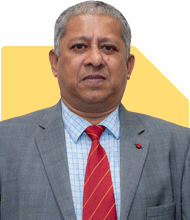Ramalingam Kalirajan |8319 Answers |Ask -Follow
Mutual Funds, Financial Planning Expert - Answered on Nov 26, 2024
He has an MBA in finance from the University of Madras and is a certified financial planner.
He is the director and chief financial planner at Holistic Investment, a Chennai-based firm that offers financial planning and wealth management advice.... more

Dear sir I am a single parent of a girl child age 14 yrs.My parents stay with me . My earning is 160000 per month wherein I have a home loan emi of 75000 and 30000 i deposit in sip, 10000 towards lic, 15000 towards home expenses. But I am left with no liquid cash in month end . How can I increase my savings in this salary as I am very worried about my future
Current Cash Flow Analysis
Income: Rs. 80,000
Expenses: Rs. 40,000
You save Rs. 40,000 monthly, which can be allocated effectively. The focus will be on balancing immediate and long-term financial goals.
Key Financial Goals
Saving for your sons' higher education (in the next 3 to 7 years).
Building a retirement corpus for financial independence by age 50.
Step 1: Allocate for Higher Education
Higher education is an urgent priority. Here’s how you can start preparing:
Dedicated Education Fund
Open a separate investment for your sons' education.
Use a combination of balanced mutual funds and fixed deposits.
Balanced mutual funds offer moderate risk and steady growth.
Estimate Education Costs
Calculate expected expenses for each child’s education.
Plan for both domestic and international options to remain flexible.
Invest Regularly
Start SIPs of Rs. 25,000 per month for their education fund.
Increase contributions by 5% annually if possible.
Step 2: Build Your Emergency Fund
An emergency fund is essential for financial security:
Set aside six months' worth of expenses, around Rs. 2.4 lakh.
Use liquid mutual funds for easy access and better returns than savings accounts.
Allocate Rs. 5,000 monthly until you build this fund.
Step 3: Plan for Retirement
You aim to retire by 50. Start building your retirement corpus now.
Monthly Retirement Contribution
Dedicate Rs. 10,000 monthly to a retirement-focused mutual fund.
Choose funds that align with your risk profile and investment horizon.
Increase Contributions Gradually
As your income grows, increase your contributions to Rs. 15,000 or more.
Regular reviews will ensure you stay on track.
Tax Benefits
Use NPS for additional tax benefits and disciplined retirement savings.
It offers a balance of equity and debt exposure.
Step 4: Insurance and Risk Management
Insurance is vital for protecting your family and assets:
Health Insurance
Ensure you have adequate health insurance for yourself and your sons.
Aim for a cover of at least Rs. 10 lakh to handle medical emergencies.
Term Life Insurance
A term policy should cover at least Rs. 1 crore.
This will secure your sons' future in case of unforeseen circumstances.
Step 5: Optimize Existing Expenses
Your monthly expenses are Rs. 40,000. To improve savings:
Track Spending
Analyse discretionary expenses like dining out, shopping, or subscriptions.
Reduce unnecessary spending by 10%-15%.
Prioritise Essentials
Focus on education, healthcare, and necessary household expenses.
Step 6: Create an Investment Plan
Investing is crucial for achieving your goals efficiently:
Diversify Investments
Use a mix of equity, debt, and hybrid mutual funds for balanced growth.
Avoid direct funds; instead, invest through a certified financial planner for professional guidance.
Avoid Index Funds
Actively managed funds outperform index funds in volatile markets.
They offer flexibility and better potential returns with skilled management.
Review Regularly
Review your investments every six months.
Shift from equity-heavy funds to safer debt funds as goals approach.
Step 7: Focus on Education Goals for Sons
Your elder son will need funds sooner than your younger one.
Stagger Fund Allocation
Allocate more for the elder son’s education immediately.
Continue contributions for the younger son’s fund with a longer horizon.
Utilise Scholarships
Encourage your sons to apply for scholarships to reduce financial strain.
Step 8: Long-Term Strategy for Financial Growth
A strategic approach will ensure steady financial growth:
Increase Income
Explore freelancing, consulting, or other income sources to supplement savings.
Utilize skills or hobbies to generate additional income.
Avoid Loans
Minimise debt by avoiding unnecessary loans or credit card usage.
Focus on clearing existing liabilities promptly.
Step 9: Tax Planning
Efficient tax planning increases disposable income:
Utilise Deductions
Maximise benefits under Section 80C, 80D, and other applicable sections.
Include NPS contributions for additional deductions under Section 80CCD.
Invest Smartly
Choose tax-efficient instruments like ELSS for dual benefits of savings and tax deductions.
Finally
Your disciplined approach provides a strong foundation. Focus on immediate education needs while building a robust retirement plan. Regularly review and adjust your plan with professional guidance to achieve your goals smoothly.
Best Regards,
K. Ramalingam, MBA, CFP,
Chief Financial Planner,
www.holisticinvestment.in
https://www.youtube.com/@HolisticInvestment
You may like to see similar questions and answers below
Hemant Bokil | Answer |Ask -Follow
Financial Planner - Answered on Apr 27, 2023
Sanjeev Govila |458 Answers |Ask -Follow
Financial Planner - Answered on Feb 06, 2024
Ramalingam Kalirajan |8319 Answers |Ask -Follow
Mutual Funds, Financial Planning Expert - Answered on Apr 24, 2024
Ramalingam Kalirajan |8319 Answers |Ask -Follow
Mutual Funds, Financial Planning Expert - Answered on Jan 28, 2025
Dr Nagarajan J S K |367 Answers |Ask -Follow
NEET, Medical, Pharmacy Careers - Answered on May 05, 2025
Prof Suvasish Mukhopadhyay |615 Answers |Ask -Follow
Career Counsellor - Answered on May 05, 2025
Dr Dipankar Dutta |1197 Answers |Ask -Follow
Tech Careers and Skill Development Expert - Answered on May 05, 2025
Radheshyam Zanwar |1599 Answers |Ask -Follow
MHT-CET, IIT-JEE, NEET-UG Expert - Answered on May 05, 2025
Radheshyam Zanwar |1599 Answers |Ask -Follow
MHT-CET, IIT-JEE, NEET-UG Expert - Answered on May 05, 2025

EEE (Electrical and Electronics Engineering) at IIIT Gwalior (ABV-IIITM) can be a decent choice. But if you're strictly interested in core electrical engineering, other colleges (like NITs) might be a better option because not many EEE-core companies visit the campus in comparison to CS/IT branches. Finally, if your interest is strictly in core EEE, IIIT Gwalior might not offer as many labs or core recruiters as older NITs or IITs with stronger electrical departments.
Follow me if you like the reply. Thanks
Radheshyam
If not followed, pl follow and like. Thanks
Radheshyam Zanwar |1599 Answers |Ask -Follow
MHT-CET, IIT-JEE, NEET-UG Expert - Answered on May 05, 2025
Prof Suvasish Mukhopadhyay |615 Answers |Ask -Follow
Career Counsellor - Answered on May 05, 2025

Prof Suvasish Mukhopadhyay |615 Answers |Ask -Follow
Career Counsellor - Answered on May 05, 2025

Mihir Tanna |1052 Answers |Ask -Follow
Tax Expert - Answered on May 05, 2025
Samraat Jadhav |2269 Answers |Ask -Follow
Stock Market Expert - Answered on May 05, 2025























